Case Study: Audit Planning and Testing for Quartet Ltd, ACCT7103, 2019
VerifiedAdded on 2022/12/28
|9
|2047
|80
Case Study
AI Summary
This case study analyzes the audit planning and testing for Quartet Ltd, focusing on the sales revenue and inventory accounts. The assignment requires an assessment of inherent and control risks, supported by analytical procedures, in accordance with Australian Auditing Standards. It examines the likelihood of misstatements, identifies internal controls, and evaluates their effectiveness. Furthermore, the case study explores tests of control for both sales revenue and inventory, recommending procedures to measure the effectiveness of the internal control systems. Finally, it outlines substantive testing procedures to detect potential misstatements, emphasizing the use of evidence to support audit opinions. The analysis considers factors such as market trends, inventory turnover, and weaknesses in internal controls to provide a comprehensive audit perspective.
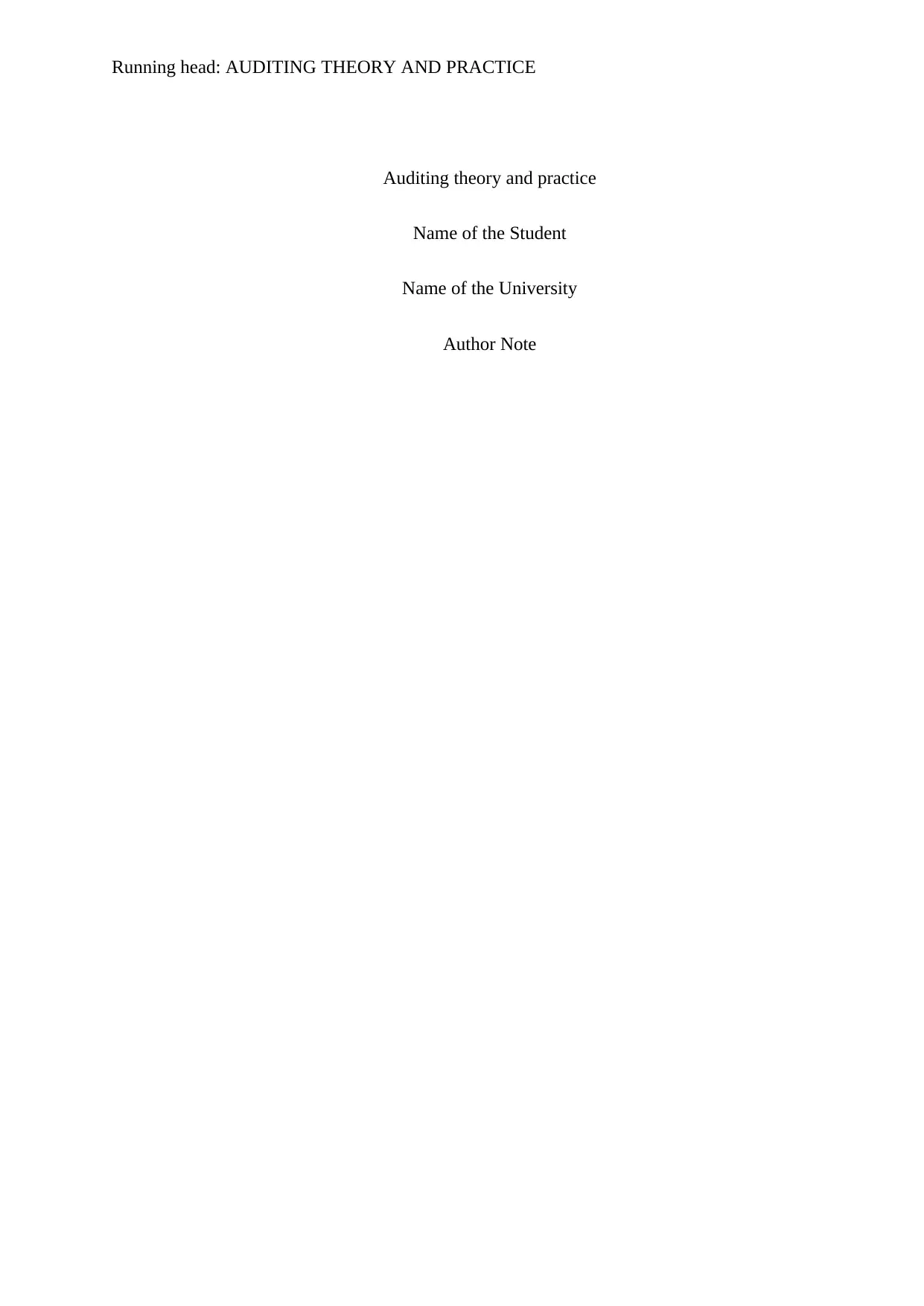
Running head: AUDITING THEORY AND PRACTICE
Auditing theory and practice
Name of the Student
Name of the University
Author Note
Auditing theory and practice
Name of the Student
Name of the University
Author Note
Paraphrase This Document
Need a fresh take? Get an instant paraphrase of this document with our AI Paraphraser

AUDITING THEORY AND PRACTICE
Table of Contents
Answer to question 1:.................................................................................................................1
Assessing the likelihood of misstatements of each of the general objectives of accounts by
using analytical procedures:.......................................................................................................1
Answer to question 2:.................................................................................................................2
Identifying the internal control of sales revenue and inventory account:..................................2
Evaluation of internal controls in determining the material misstatement of accounts:............2
Answer to question 3:.................................................................................................................2
Answer to question 4:.................................................................................................................2
References list:...........................................................................................................................3
Table of Contents
Answer to question 1:.................................................................................................................1
Assessing the likelihood of misstatements of each of the general objectives of accounts by
using analytical procedures:.......................................................................................................1
Answer to question 2:.................................................................................................................2
Identifying the internal control of sales revenue and inventory account:..................................2
Evaluation of internal controls in determining the material misstatement of accounts:............2
Answer to question 3:.................................................................................................................2
Answer to question 4:.................................................................................................................2
References list:...........................................................................................................................3
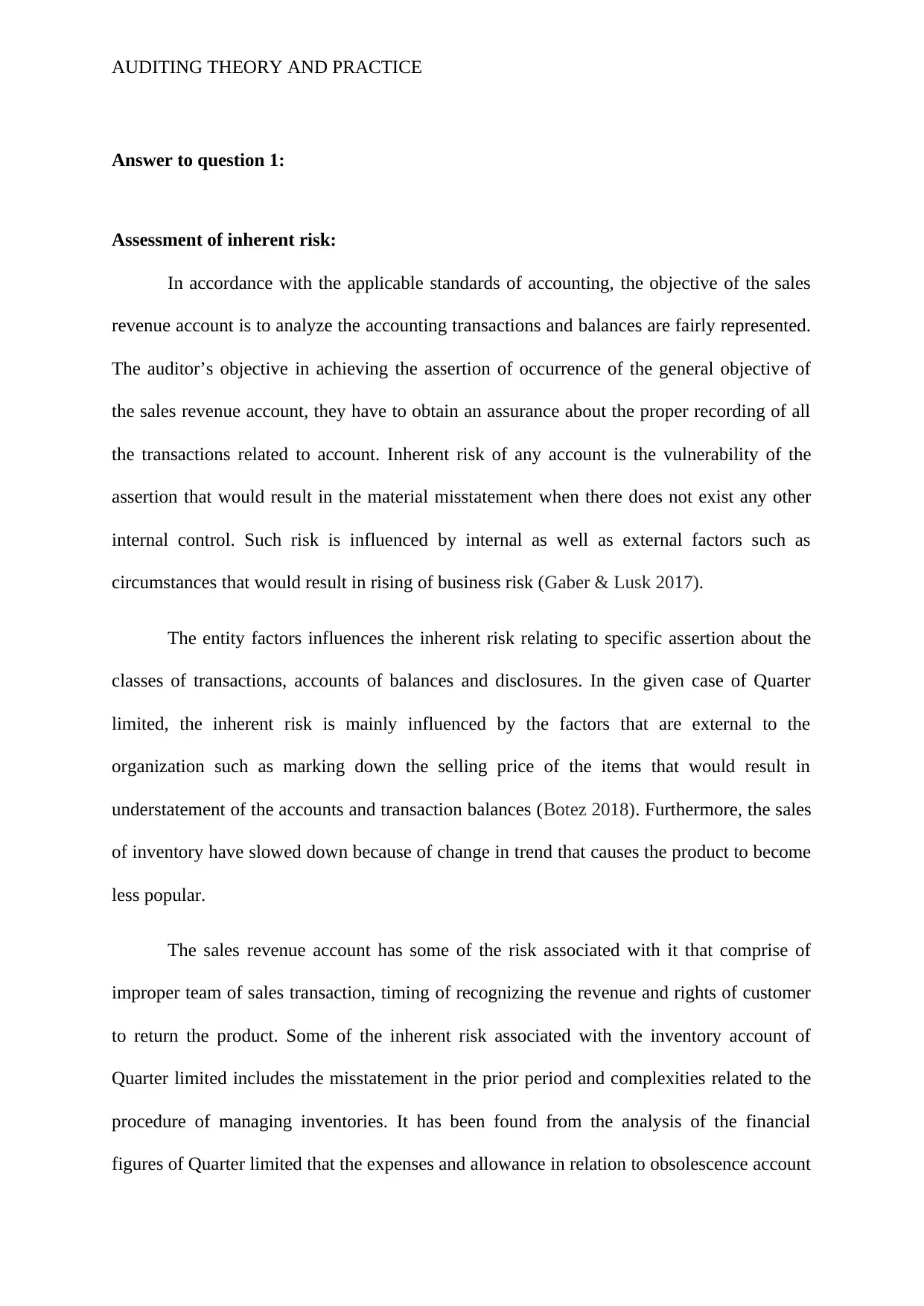
AUDITING THEORY AND PRACTICE
Answer to question 1:
Assessment of inherent risk:
In accordance with the applicable standards of accounting, the objective of the sales
revenue account is to analyze the accounting transactions and balances are fairly represented.
The auditor’s objective in achieving the assertion of occurrence of the general objective of
the sales revenue account, they have to obtain an assurance about the proper recording of all
the transactions related to account. Inherent risk of any account is the vulnerability of the
assertion that would result in the material misstatement when there does not exist any other
internal control. Such risk is influenced by internal as well as external factors such as
circumstances that would result in rising of business risk (Gaber & Lusk 2017).
The entity factors influences the inherent risk relating to specific assertion about the
classes of transactions, accounts of balances and disclosures. In the given case of Quarter
limited, the inherent risk is mainly influenced by the factors that are external to the
organization such as marking down the selling price of the items that would result in
understatement of the accounts and transaction balances (Botez 2018). Furthermore, the sales
of inventory have slowed down because of change in trend that causes the product to become
less popular.
The sales revenue account has some of the risk associated with it that comprise of
improper team of sales transaction, timing of recognizing the revenue and rights of customer
to return the product. Some of the inherent risk associated with the inventory account of
Quarter limited includes the misstatement in the prior period and complexities related to the
procedure of managing inventories. It has been found from the analysis of the financial
figures of Quarter limited that the expenses and allowance in relation to obsolescence account
Answer to question 1:
Assessment of inherent risk:
In accordance with the applicable standards of accounting, the objective of the sales
revenue account is to analyze the accounting transactions and balances are fairly represented.
The auditor’s objective in achieving the assertion of occurrence of the general objective of
the sales revenue account, they have to obtain an assurance about the proper recording of all
the transactions related to account. Inherent risk of any account is the vulnerability of the
assertion that would result in the material misstatement when there does not exist any other
internal control. Such risk is influenced by internal as well as external factors such as
circumstances that would result in rising of business risk (Gaber & Lusk 2017).
The entity factors influences the inherent risk relating to specific assertion about the
classes of transactions, accounts of balances and disclosures. In the given case of Quarter
limited, the inherent risk is mainly influenced by the factors that are external to the
organization such as marking down the selling price of the items that would result in
understatement of the accounts and transaction balances (Botez 2018). Furthermore, the sales
of inventory have slowed down because of change in trend that causes the product to become
less popular.
The sales revenue account has some of the risk associated with it that comprise of
improper team of sales transaction, timing of recognizing the revenue and rights of customer
to return the product. Some of the inherent risk associated with the inventory account of
Quarter limited includes the misstatement in the prior period and complexities related to the
procedure of managing inventories. It has been found from the analysis of the financial
figures of Quarter limited that the expenses and allowance in relation to obsolescence account
⊘ This is a preview!⊘
Do you want full access?
Subscribe today to unlock all pages.

Trusted by 1+ million students worldwide
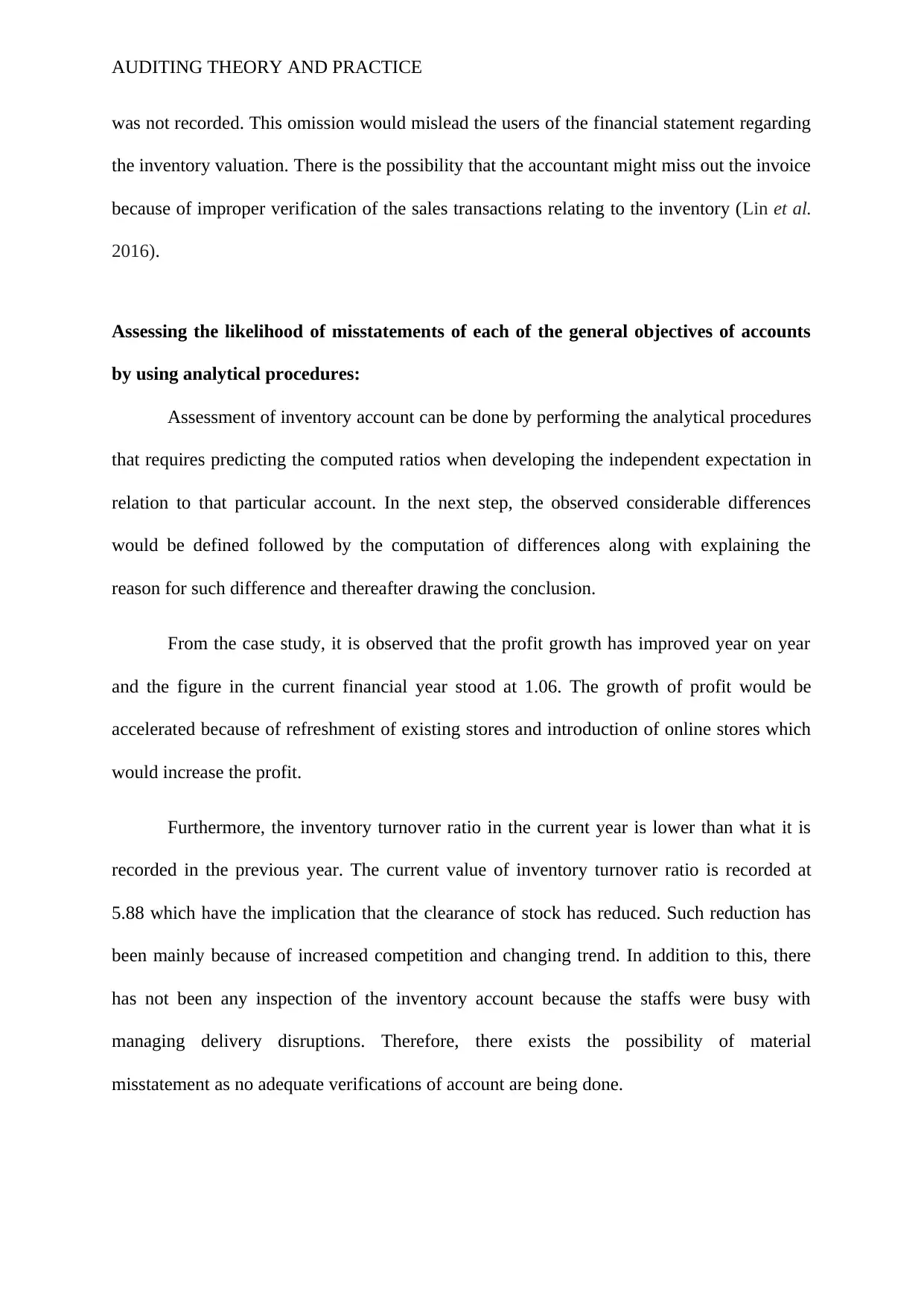
AUDITING THEORY AND PRACTICE
was not recorded. This omission would mislead the users of the financial statement regarding
the inventory valuation. There is the possibility that the accountant might miss out the invoice
because of improper verification of the sales transactions relating to the inventory (Lin et al.
2016).
Assessing the likelihood of misstatements of each of the general objectives of accounts
by using analytical procedures:
Assessment of inventory account can be done by performing the analytical procedures
that requires predicting the computed ratios when developing the independent expectation in
relation to that particular account. In the next step, the observed considerable differences
would be defined followed by the computation of differences along with explaining the
reason for such difference and thereafter drawing the conclusion.
From the case study, it is observed that the profit growth has improved year on year
and the figure in the current financial year stood at 1.06. The growth of profit would be
accelerated because of refreshment of existing stores and introduction of online stores which
would increase the profit.
Furthermore, the inventory turnover ratio in the current year is lower than what it is
recorded in the previous year. The current value of inventory turnover ratio is recorded at
5.88 which have the implication that the clearance of stock has reduced. Such reduction has
been mainly because of increased competition and changing trend. In addition to this, there
has not been any inspection of the inventory account because the staffs were busy with
managing delivery disruptions. Therefore, there exists the possibility of material
misstatement as no adequate verifications of account are being done.
was not recorded. This omission would mislead the users of the financial statement regarding
the inventory valuation. There is the possibility that the accountant might miss out the invoice
because of improper verification of the sales transactions relating to the inventory (Lin et al.
2016).
Assessing the likelihood of misstatements of each of the general objectives of accounts
by using analytical procedures:
Assessment of inventory account can be done by performing the analytical procedures
that requires predicting the computed ratios when developing the independent expectation in
relation to that particular account. In the next step, the observed considerable differences
would be defined followed by the computation of differences along with explaining the
reason for such difference and thereafter drawing the conclusion.
From the case study, it is observed that the profit growth has improved year on year
and the figure in the current financial year stood at 1.06. The growth of profit would be
accelerated because of refreshment of existing stores and introduction of online stores which
would increase the profit.
Furthermore, the inventory turnover ratio in the current year is lower than what it is
recorded in the previous year. The current value of inventory turnover ratio is recorded at
5.88 which have the implication that the clearance of stock has reduced. Such reduction has
been mainly because of increased competition and changing trend. In addition to this, there
has not been any inspection of the inventory account because the staffs were busy with
managing delivery disruptions. Therefore, there exists the possibility of material
misstatement as no adequate verifications of account are being done.
Paraphrase This Document
Need a fresh take? Get an instant paraphrase of this document with our AI Paraphraser

AUDITING THEORY AND PRACTICE
Answer to question 2:
Identifying the internal control of sales revenue and inventory account:
Internal controls are the policies that are implemented by the organization for
protection of their acquired assets and their effectiveness helps in influencing the materiality
of accounts. Control risk is the risk of not managing the inventory because of lack of internal
control and the assessment of internal control are done by using control risk.
Quarter limited has implemented the internal control for managing their sales revenue
account and such control comprised of preparation of delivery documents, numbering the
sales invoices serially, preparation of monthly inventory reports and document authorizations.
However, the internal control of this particular account comes with few weaknesses that
might lead to improper accounting for transactions such as there exist the probability of
preparation of duplicate documents because the invoices might miss out as they are not
verified against delivery documents (Uludağ 2016) .
In addition to this, only sales staffs have access to the management system of
inventory which is integrated with sales system as the accounts are password protected.
Moreover, the authority for processing the transactions of inventory system rest with the
warehouse managers which makes it difficult and reduced the chances of error and fraud
activities (Gaber & Lusk 2017). Nonetheless, there can be material misstatement of the
inventory account because of uncertainty in the unrealized inventory amount that is not
recorded.
Evaluation of internal controls in determining the material misstatement of accounts:
Quarter limited and its staffs have less probability of making fraud because the access
to the inventory management system is protected by passwords. The material misstatement of
Answer to question 2:
Identifying the internal control of sales revenue and inventory account:
Internal controls are the policies that are implemented by the organization for
protection of their acquired assets and their effectiveness helps in influencing the materiality
of accounts. Control risk is the risk of not managing the inventory because of lack of internal
control and the assessment of internal control are done by using control risk.
Quarter limited has implemented the internal control for managing their sales revenue
account and such control comprised of preparation of delivery documents, numbering the
sales invoices serially, preparation of monthly inventory reports and document authorizations.
However, the internal control of this particular account comes with few weaknesses that
might lead to improper accounting for transactions such as there exist the probability of
preparation of duplicate documents because the invoices might miss out as they are not
verified against delivery documents (Uludağ 2016) .
In addition to this, only sales staffs have access to the management system of
inventory which is integrated with sales system as the accounts are password protected.
Moreover, the authority for processing the transactions of inventory system rest with the
warehouse managers which makes it difficult and reduced the chances of error and fraud
activities (Gaber & Lusk 2017). Nonetheless, there can be material misstatement of the
inventory account because of uncertainty in the unrealized inventory amount that is not
recorded.
Evaluation of internal controls in determining the material misstatement of accounts:
Quarter limited and its staffs have less probability of making fraud because the access
to the inventory management system is protected by passwords. The material misstatement of
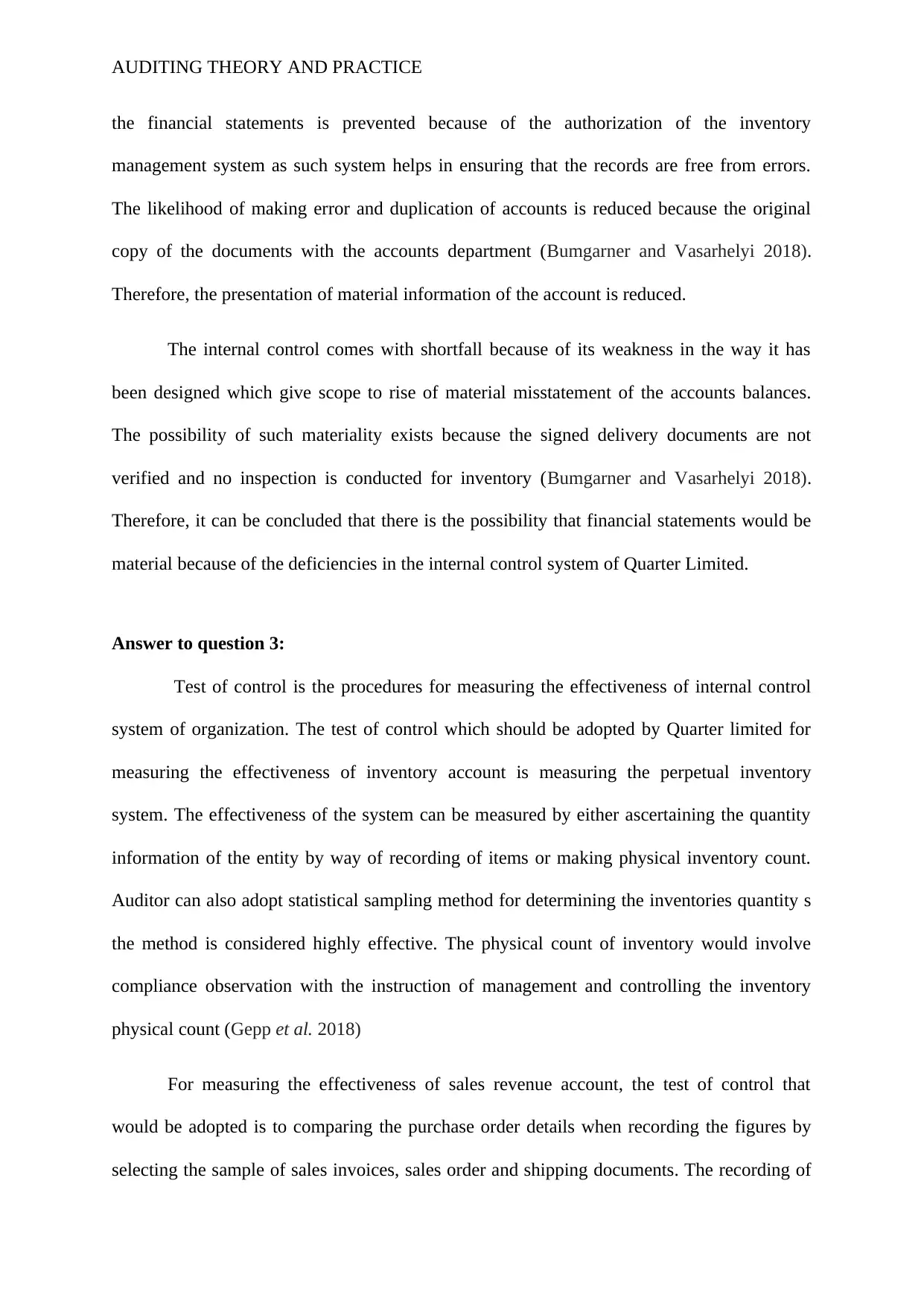
AUDITING THEORY AND PRACTICE
the financial statements is prevented because of the authorization of the inventory
management system as such system helps in ensuring that the records are free from errors.
The likelihood of making error and duplication of accounts is reduced because the original
copy of the documents with the accounts department (Bumgarner and Vasarhelyi 2018).
Therefore, the presentation of material information of the account is reduced.
The internal control comes with shortfall because of its weakness in the way it has
been designed which give scope to rise of material misstatement of the accounts balances.
The possibility of such materiality exists because the signed delivery documents are not
verified and no inspection is conducted for inventory (Bumgarner and Vasarhelyi 2018).
Therefore, it can be concluded that there is the possibility that financial statements would be
material because of the deficiencies in the internal control system of Quarter Limited.
Answer to question 3:
Test of control is the procedures for measuring the effectiveness of internal control
system of organization. The test of control which should be adopted by Quarter limited for
measuring the effectiveness of inventory account is measuring the perpetual inventory
system. The effectiveness of the system can be measured by either ascertaining the quantity
information of the entity by way of recording of items or making physical inventory count.
Auditor can also adopt statistical sampling method for determining the inventories quantity s
the method is considered highly effective. The physical count of inventory would involve
compliance observation with the instruction of management and controlling the inventory
physical count (Gepp et al. 2018)
For measuring the effectiveness of sales revenue account, the test of control that
would be adopted is to comparing the purchase order details when recording the figures by
selecting the sample of sales invoices, sales order and shipping documents. The recording of
the financial statements is prevented because of the authorization of the inventory
management system as such system helps in ensuring that the records are free from errors.
The likelihood of making error and duplication of accounts is reduced because the original
copy of the documents with the accounts department (Bumgarner and Vasarhelyi 2018).
Therefore, the presentation of material information of the account is reduced.
The internal control comes with shortfall because of its weakness in the way it has
been designed which give scope to rise of material misstatement of the accounts balances.
The possibility of such materiality exists because the signed delivery documents are not
verified and no inspection is conducted for inventory (Bumgarner and Vasarhelyi 2018).
Therefore, it can be concluded that there is the possibility that financial statements would be
material because of the deficiencies in the internal control system of Quarter Limited.
Answer to question 3:
Test of control is the procedures for measuring the effectiveness of internal control
system of organization. The test of control which should be adopted by Quarter limited for
measuring the effectiveness of inventory account is measuring the perpetual inventory
system. The effectiveness of the system can be measured by either ascertaining the quantity
information of the entity by way of recording of items or making physical inventory count.
Auditor can also adopt statistical sampling method for determining the inventories quantity s
the method is considered highly effective. The physical count of inventory would involve
compliance observation with the instruction of management and controlling the inventory
physical count (Gepp et al. 2018)
For measuring the effectiveness of sales revenue account, the test of control that
would be adopted is to comparing the purchase order details when recording the figures by
selecting the sample of sales invoices, sales order and shipping documents. The recording of
⊘ This is a preview!⊘
Do you want full access?
Subscribe today to unlock all pages.

Trusted by 1+ million students worldwide
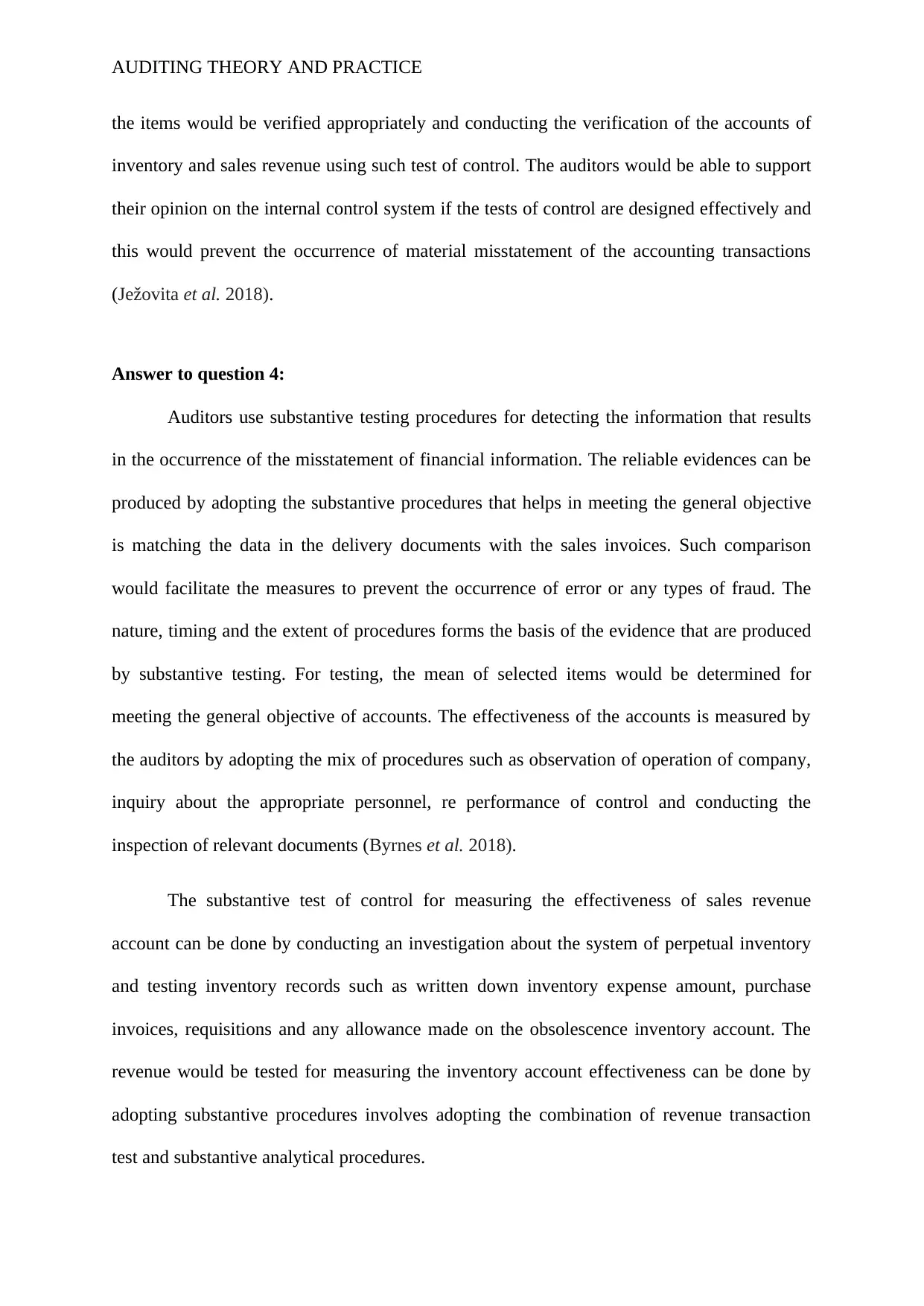
AUDITING THEORY AND PRACTICE
the items would be verified appropriately and conducting the verification of the accounts of
inventory and sales revenue using such test of control. The auditors would be able to support
their opinion on the internal control system if the tests of control are designed effectively and
this would prevent the occurrence of material misstatement of the accounting transactions
(Ježovita et al. 2018).
Answer to question 4:
Auditors use substantive testing procedures for detecting the information that results
in the occurrence of the misstatement of financial information. The reliable evidences can be
produced by adopting the substantive procedures that helps in meeting the general objective
is matching the data in the delivery documents with the sales invoices. Such comparison
would facilitate the measures to prevent the occurrence of error or any types of fraud. The
nature, timing and the extent of procedures forms the basis of the evidence that are produced
by substantive testing. For testing, the mean of selected items would be determined for
meeting the general objective of accounts. The effectiveness of the accounts is measured by
the auditors by adopting the mix of procedures such as observation of operation of company,
inquiry about the appropriate personnel, re performance of control and conducting the
inspection of relevant documents (Byrnes et al. 2018).
The substantive test of control for measuring the effectiveness of sales revenue
account can be done by conducting an investigation about the system of perpetual inventory
and testing inventory records such as written down inventory expense amount, purchase
invoices, requisitions and any allowance made on the obsolescence inventory account. The
revenue would be tested for measuring the inventory account effectiveness can be done by
adopting substantive procedures involves adopting the combination of revenue transaction
test and substantive analytical procedures.
the items would be verified appropriately and conducting the verification of the accounts of
inventory and sales revenue using such test of control. The auditors would be able to support
their opinion on the internal control system if the tests of control are designed effectively and
this would prevent the occurrence of material misstatement of the accounting transactions
(Ježovita et al. 2018).
Answer to question 4:
Auditors use substantive testing procedures for detecting the information that results
in the occurrence of the misstatement of financial information. The reliable evidences can be
produced by adopting the substantive procedures that helps in meeting the general objective
is matching the data in the delivery documents with the sales invoices. Such comparison
would facilitate the measures to prevent the occurrence of error or any types of fraud. The
nature, timing and the extent of procedures forms the basis of the evidence that are produced
by substantive testing. For testing, the mean of selected items would be determined for
meeting the general objective of accounts. The effectiveness of the accounts is measured by
the auditors by adopting the mix of procedures such as observation of operation of company,
inquiry about the appropriate personnel, re performance of control and conducting the
inspection of relevant documents (Byrnes et al. 2018).
The substantive test of control for measuring the effectiveness of sales revenue
account can be done by conducting an investigation about the system of perpetual inventory
and testing inventory records such as written down inventory expense amount, purchase
invoices, requisitions and any allowance made on the obsolescence inventory account. The
revenue would be tested for measuring the inventory account effectiveness can be done by
adopting substantive procedures involves adopting the combination of revenue transaction
test and substantive analytical procedures.
Paraphrase This Document
Need a fresh take? Get an instant paraphrase of this document with our AI Paraphraser
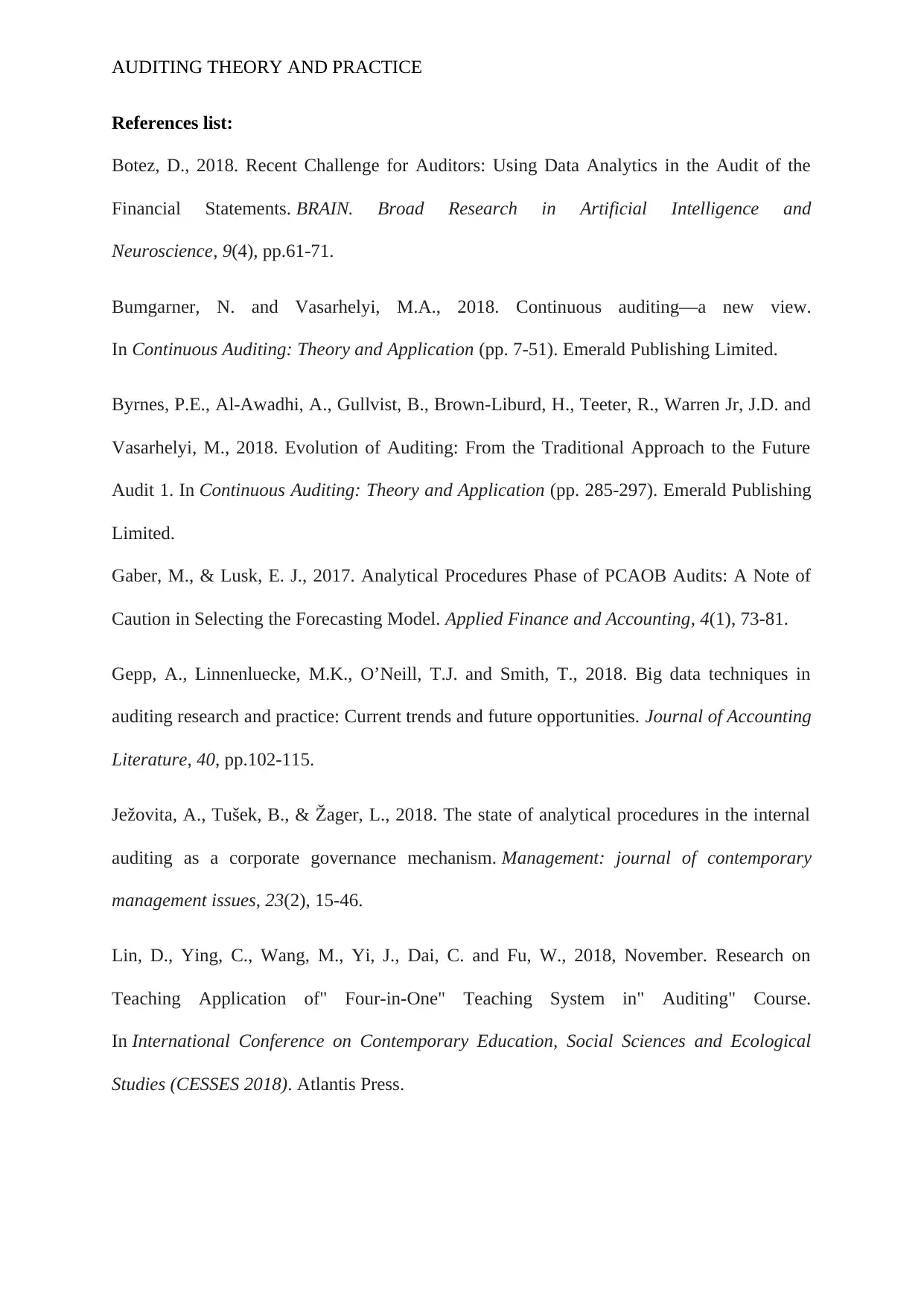
AUDITING THEORY AND PRACTICE
References list:
Botez, D., 2018. Recent Challenge for Auditors: Using Data Analytics in the Audit of the
Financial Statements. BRAIN. Broad Research in Artificial Intelligence and
Neuroscience, 9(4), pp.61-71.
Bumgarner, N. and Vasarhelyi, M.A., 2018. Continuous auditing—a new view.
In Continuous Auditing: Theory and Application (pp. 7-51). Emerald Publishing Limited.
Byrnes, P.E., Al-Awadhi, A., Gullvist, B., Brown-Liburd, H., Teeter, R., Warren Jr, J.D. and
Vasarhelyi, M., 2018. Evolution of Auditing: From the Traditional Approach to the Future
Audit 1. In Continuous Auditing: Theory and Application (pp. 285-297). Emerald Publishing
Limited.
Gaber, M., & Lusk, E. J., 2017. Analytical Procedures Phase of PCAOB Audits: A Note of
Caution in Selecting the Forecasting Model. Applied Finance and Accounting, 4(1), 73-81.
Gepp, A., Linnenluecke, M.K., O’Neill, T.J. and Smith, T., 2018. Big data techniques in
auditing research and practice: Current trends and future opportunities. Journal of Accounting
Literature, 40, pp.102-115.
Ježovita, A., Tušek, B., & Žager, L., 2018. The state of analytical procedures in the internal
auditing as a corporate governance mechanism. Management: journal of contemporary
management issues, 23(2), 15-46.
Lin, D., Ying, C., Wang, M., Yi, J., Dai, C. and Fu, W., 2018, November. Research on
Teaching Application of" Four-in-One" Teaching System in" Auditing" Course.
In International Conference on Contemporary Education, Social Sciences and Ecological
Studies (CESSES 2018). Atlantis Press.
References list:
Botez, D., 2018. Recent Challenge for Auditors: Using Data Analytics in the Audit of the
Financial Statements. BRAIN. Broad Research in Artificial Intelligence and
Neuroscience, 9(4), pp.61-71.
Bumgarner, N. and Vasarhelyi, M.A., 2018. Continuous auditing—a new view.
In Continuous Auditing: Theory and Application (pp. 7-51). Emerald Publishing Limited.
Byrnes, P.E., Al-Awadhi, A., Gullvist, B., Brown-Liburd, H., Teeter, R., Warren Jr, J.D. and
Vasarhelyi, M., 2018. Evolution of Auditing: From the Traditional Approach to the Future
Audit 1. In Continuous Auditing: Theory and Application (pp. 285-297). Emerald Publishing
Limited.
Gaber, M., & Lusk, E. J., 2017. Analytical Procedures Phase of PCAOB Audits: A Note of
Caution in Selecting the Forecasting Model. Applied Finance and Accounting, 4(1), 73-81.
Gepp, A., Linnenluecke, M.K., O’Neill, T.J. and Smith, T., 2018. Big data techniques in
auditing research and practice: Current trends and future opportunities. Journal of Accounting
Literature, 40, pp.102-115.
Ježovita, A., Tušek, B., & Žager, L., 2018. The state of analytical procedures in the internal
auditing as a corporate governance mechanism. Management: journal of contemporary
management issues, 23(2), 15-46.
Lin, D., Ying, C., Wang, M., Yi, J., Dai, C. and Fu, W., 2018, November. Research on
Teaching Application of" Four-in-One" Teaching System in" Auditing" Course.
In International Conference on Contemporary Education, Social Sciences and Ecological
Studies (CESSES 2018). Atlantis Press.

AUDITING THEORY AND PRACTICE
Uludağ, S., 2016. The importance of control environment in an organization for an
independent auditor to determine nature, timing, and extent of substantive tests: An
application in Turkey. JABS, 2(6), 294-303.
Uludağ, S., 2016. The importance of control environment in an organization for an
independent auditor to determine nature, timing, and extent of substantive tests: An
application in Turkey. JABS, 2(6), 294-303.
⊘ This is a preview!⊘
Do you want full access?
Subscribe today to unlock all pages.

Trusted by 1+ million students worldwide
1 out of 9
Related Documents
Your All-in-One AI-Powered Toolkit for Academic Success.
+13062052269
info@desklib.com
Available 24*7 on WhatsApp / Email
![[object Object]](/_next/static/media/star-bottom.7253800d.svg)
Unlock your academic potential
Copyright © 2020–2025 A2Z Services. All Rights Reserved. Developed and managed by ZUCOL.




